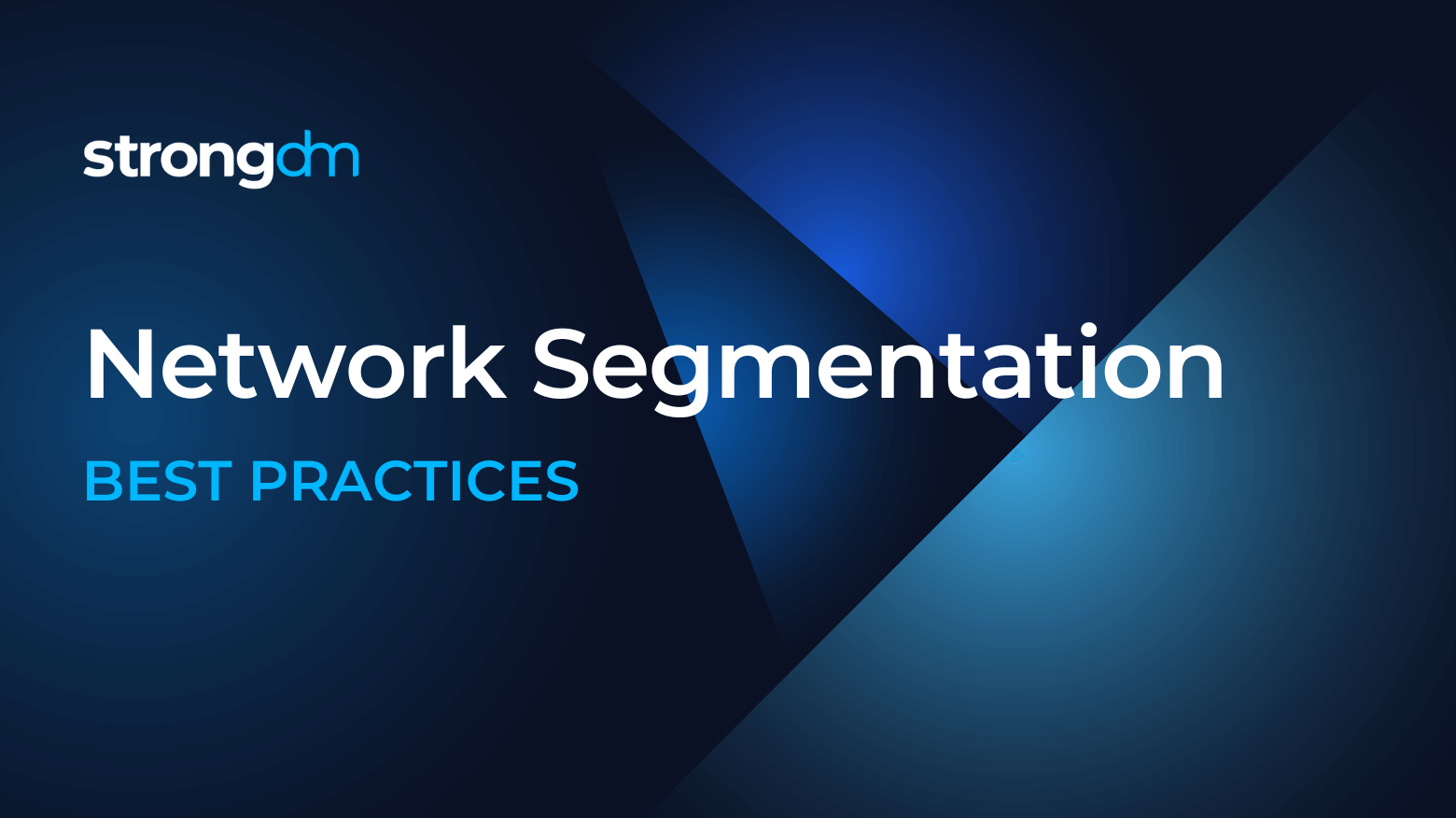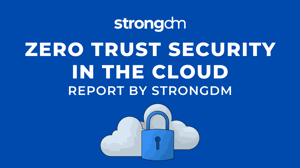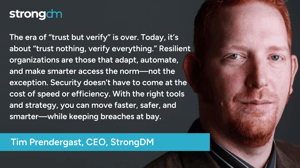7 Network Segmentation Best Practices to Level-up Your Security


Written by
John TurnerLast updated on:
June 25, 2025Reading time:
Contents
Built for Security. Loved by Devs.
- Free Trial — No Credit Card Needed
- Full Access to All Features
- Trusted by the Fortune 100, early startups, and everyone in between
In this article, we’ll discuss network segmentation, including what it is, why it’s important, and the benefits of implementing a robust network segmentation strategy. Plus, we’ll help you improve security across your entire network by reviewing the following network segmentation best practices:
- Follow least privilege
- Limit third-party access
- Audit and monitor your network
- Make legitimate paths to access easier than illegitimate paths
- Combine similar network resources
- Don’t oversegment
- Visualize your network
What is Network Segmentation?
Network segmentation (also known as network partitioning or network isolation) is the practice of dividing a computer network into multiple subnetworks in order to improve performance and security.
By isolating (or segmenting) the network into separate contained parts, network segmentation effectively prevents a single point of failure and makes it difficult for unauthorized users to compromise the entire network.
For example, if a bad actor gains access to your network, they will attempt to move around the network to access and exploit sensitive data. If you have a flat network (an architecture where all systems connect without going through intermediary devices such as a bridge or router), it is relatively easy for a bad actor to gain access to the entire system through one access point. While flat networks provide fast and reliable connectivity, this lateral access between systems makes them especially vulnerable within today’s modern and complex interconnected organizations.
However, when the network is segmented, malicious traffic won’t have immediate access to the entire ecosystem. Attackers will only be able to access the initial section they breached, giving IT time to locate the breach and minimize the impact of the intrusion.
Benefits of Network Segmentation
According to a report by IBM, data breach costs rose from $3.86 million to $4.24 million USD—the highest average total cost in 17 years. These rising costs—and the expansion of remote work—have placed cybersecurity as a top priority for organizations in 2021.
Network segmentation has become a key strategy for organizations looking to secure complex networks. And for good reason.
So what are the benefits of network segmentation? A few include:
- Strengthened security. Network segmentation minimizes security risks by creating a multi-layer attack surface that prevents lateral network attacks. As a result, even if attackers breach your first perimeter of defense, they are contained within the network segment they access.
- Improved network monitoring. Dividing your network into organized segments makes it easier to isolate incidents and quickly identify threats.
- Enhanced operational performance. Traffic is limited to specific zones based on need. This reduces the number of hosts and users within any given subnet, decreasing congestion and boosting performance across the board.
- Reduced the scope of compliance. Segmentation allows you to separate regulated data from your other systems, making it easier to manage compliance and apply policies with a targeted approach.
What Is an Example of a Network Segment?
There are a few ways to segment your network. Typically segmentation is done through a combination of firewalls, Virtual Local Area Networks (VLANs), and Software Defined Networking (SDN).
VLAN segmentation: Networks are typically segmented with VLANs or subnets. VLANs create smaller network segments that connect hosts virtually. Subnets use IP addresses to segment the network, connected by networking devices. Although these approaches effectively segment the network, they often require comprehensive re-architecting and can be complex to maintain.
Firewall segmentation: Firewalls are an alternative way to enforce segmentation. Firewalls are deployed inside the network to create internal zones that partition functional areas from one another.
SDN segmentation: A more modern approach to segmentation applies an SDN-automated network overlay. One challenge with this approach is the level of complexity required for successful micro-segmentation.
7 Network Segmentation & Segregation Best Practices
1. Follow Least Privilege
When segmenting your network, it’s important to minimize who and what has access within and across systems according to actual need. In other words, not everyone needs access to every part of the network.
By following the principle of least privilege and role-based access, you can limit hosts, services, users, and networks from accessing data and functions that are outside their immediate responsibility. This strengthens your overall network security posture while also making it easier to monitor and track traffic throughout your network.
2. Limit third-party access
Similarly, it’s important to limit third-party access to your network to minimize exploitable entry points. Third-party remote access risks remain a key vulnerability for organizations. In fact, a recent report found that 44% of organizations experienced a breach in the last 12 months, with 74% saying it was the result of giving too much privileged access to third parties.
“Providing remote access to third parties without implementing the appropriate security safeguards is almost guaranteeing a security incident and a data breach involving sensitive and confidential information,” said Dr. Larry Ponemon, Chairman and Founder of Ponemon Institute. “It is important that organizations assess the security and privacy practices of the third parties that have access to their networks and ensure that they have just enough access to perform their designated responsibilities and nothing more.”
One way to do this is to create isolated portals for third parties that need access to your network to provide services. This keeps their access limited to just those areas of your network that are necessary.
3. Audit and monitor your network
Segmenting your network is just the first step to a strong segmentation strategy. The next step is continually monitoring and auditing your network to ensure the architecture is secure and identify gaps in your subnetworks that could be exploited.
Monitor your network so you can quickly identify and isolate traffic or security issues. Then conduct regular audits to surface architectural weaknesses.
This is especially important as your business evolves and grows; as your business changes, your network architecture may no longer meet your needs. Regular audits can help you assess when and where you need to adjust your network segmentation design for optimal performance and security.
4. Make legitimate paths to access easier than illegitimate paths
When evaluating and planning your architecture design, pay attention to how you plot access and what paths users will take to connect to your network. While it is important to create secure access points for your users, pay attention to how bad actors might try to access those same subnetworks illegitimately.
For instance, suppose you have firewalls sitting between your vendors and the data they need to access, but only some of these firewalls are able to block bad actors. If this is the case, you will need to rethink your architecture. Design your network so that legitimate paths are easier to navigate than illegitimate paths in order to shore up your security.
5. Combine similar network resources
Save time and reduce security overhead by combining similar network resources into individual databases. As you review your network, categorize data by type and degree of sensitivity. Segmenting your network this way allows you to quickly apply security policies while protecting data more efficiently.
6. Don’t over-segment
Gartner notes that one of the most common errors organizations make when segmenting their networks is over-segmenting, or creating too many zones. Having too many segments adds unnecessary complexity and makes it harder to manage your network as a whole.
Keep in mind, you must create policies that define what has access between each pair of zones. So the more zones you create, the more policies you need to manage. Oversegmenting can quickly expand the scope of your security management, making it costly and inefficient. Think of it this way: While you want to group similar network resources, be careful to “build a fence around the car park, not a fence and gate around every car.”
7. Visualize your network
In order to design effective and secure network architecture, you first need to understand who your users are, what components make up your network, and how all the systems relate to one another. In other words, without a clear picture of your current state, it will be difficult to plan and achieve your desired state.
Visualize your network with a network diagram to get a bird’s eye view of all the moving parts and identify who needs access to what data so you can map your network successfully.
Fewer Headaches, Better Security
How can segmenting be done so that you secure access to sensitive systems without creating a headache for engineers?
In the past, the answer would have been to manage multiple VPNs. But, that introduces a bunch of problems, including:
- Scalability—you end up becoming more permissive to keep the rules list to a manageable size.
- Performance impact—VPNs add complexity to networks, which can increase latency and impact application performance.
- Insufficient audit trails that don’t detail who performed each query or command—only that a session occurred.
A software-defined network like StrongDM is easy to adopt and maintain. StrongDM takes the guesswork out of segmentation so you can design a secure architecture from the start. StrongDM is an SDN that routes database queries, SSH, RDP, & kubectl commands through a gateway(s) to any database, server, or Kubernetes cluster. StrongDM helps you:
- Enhance your security posture by enforcing least privilege by default, so users inherit role-based access controls.
- Reduce your threat surface. With StrongDM, access is restricted to specific database/server permissions, not the broader network.
- Monitor your network with confidence through a robust forensic audit trail. StrongDM logs every query, SSH, RDP, & kubectl.
Use StrongDM to enforce network segmentation in a way that doesn’t create roadblocks for staff who require access across systems.
Network Segmentation FAQ
Who needs network segmentation?
Organizations of all sizes, especially those handling sensitive data, require network segmentation to enhance security, limit unauthorized access, and improve network performance. This includes:
- Enterprises with complex IT environments
- Healthcare organizations to protect patient data
- Financial institutions for compliance and fraud prevention
- Government agencies to safeguard classified information
- Cloud and SaaS providers to isolate workloads and users
Is network segmentation the same as VLAN?
No, network segmentation and VLANs are not the same, but VLANs are one method of implementing segmentation.
- Network segmentation is a broader security strategy that divides a network into smaller subnetworks to improve security and performance.
- VLAN (Virtual Local Area Network) is a specific technique that logically separates networks at Layer 2 of the OSI model.
While VLANs segment traffic, additional security controls like firewalls or SDN (Software-Defined Networking) are often required for stronger segmentation.
Next Steps
StrongDM unifies access management across databases, servers, clusters, and more—for IT, security, and DevOps teams.
- Learn how StrongDM works
- Book a personalized demo
- Start your free StrongDM trial

Categories:

About the Author
John Turner, Customer Engineering Expert, is passionate about helping customers connect to the infrastructure they need to do their jobs, bringing 15+ years of experience in IT environments to his current focus on Infrastructure Automation and Security. He works in multiple cloud environments including AWS, GCP, Azure, and IBM Cloud and stays up to date on various automation tools such as Terraform and Ansible. To contact John, visit his YouTube channel.
You May Also Like




